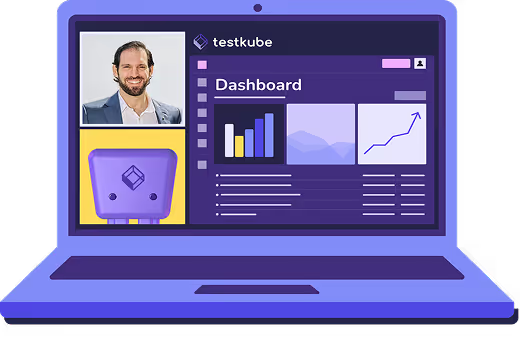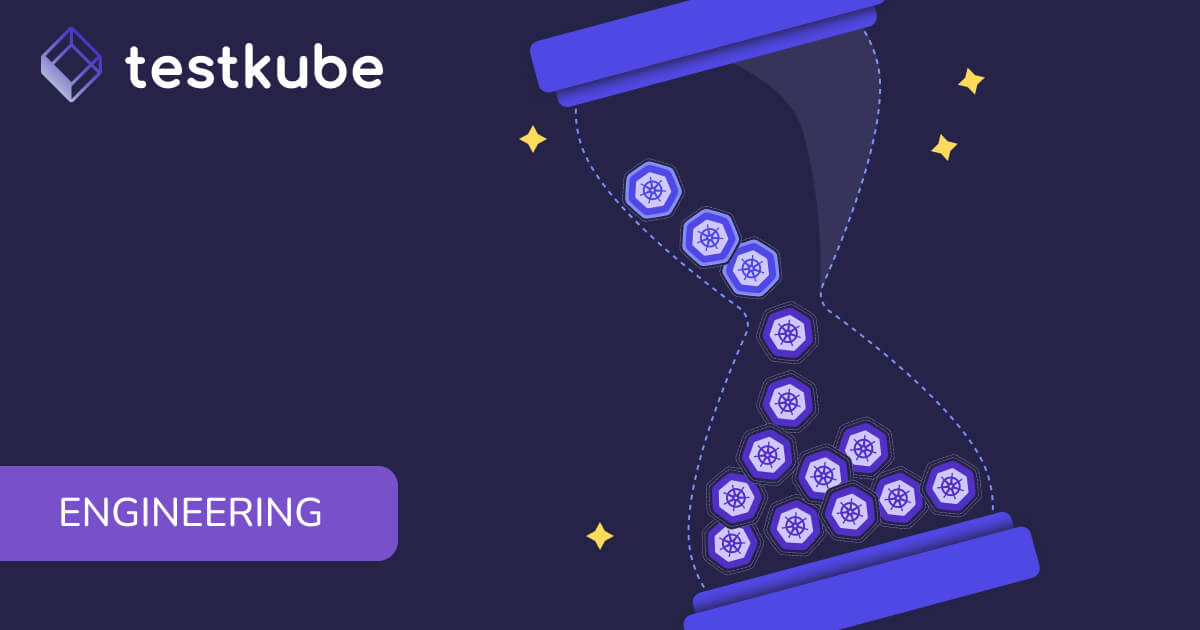

Table of Contents
Try Testkube instantly in our sandbox. No setup needed.
Try Testkube instantly in our sandbox. No setup needed.




Table of Contents
Executive Summary
It’s 2025, and while container technologies have matured and become mainstream, the question of finding the perfect timing for Kubernetes adoption remains unanswered.
Early-stage start-ups are racing towards finding the perfect product-market fit, growth-stage companies are navigating the scaling walls, while large enterprises are struggling with legacy migration. I've seen some startups develop a Kubernetes adoption strategy focused not on immediate benefits, but on long-term competitive positioningI’ve seen some startups adopt Kubernetes not for immediate benefits, but to remain competitive in the long run. Conversely, I’ve also witnessed growth-stage companies delay adoption to prevent overburdening their engineering teams.
Kubernetes isn’t just about container orchestration anymore; it’s an operational paradigm that will reshape how your teams build, deploy, and scale. However, the question is whether you can afford the learning curve now versus the migration cost later?
In this post, I’ll try to break down the strategic factors that should drive this decision, unearth the hidden costs on both sides, and provide a framework for engineering teams to time the adoption.
The Two Camps
I stumbled across a Reddit discussion in r/kubernetes - “Should we deploy on Kubernetes right from the start, or wait until we actually need it?” The 50+ comments that followed revealed a split community along predictable lines, but with nuanced arguments that go beyond “it depends”.
"Start Simple" Advocates
The “wait unless you need it” camp makes a compelling case for restraint and starting simple. They focus on the fact that early-stage engineering teams often operate with limited bandwidth. If you implement Kubernetes, your engineering team might get tangled in the infrastructure complexity, derailing product development.
One of the engineers focused on the business and customer value, pointing out that “If it’s a startup, any effort should be rewarded with a solution that gives your company something to sell. That path to a sale may not necessarily be through Kubernetes.” They emphasize that time spent configuring Kubernetes isn’t spent on delivering customer value.
Another user, drawing from their consulting experience, pointed out, “I don’t think you should start using Kubernetes before you actually have loads of services. The costs, complexity, and performance needed are not worth it early on.” They focused on the fact that a small engineering team often lacks the expertise required for configuring, upgrading, and troubleshooting.
Responses from a few users also challenged the “Kubernetes adoption is inevitable” narrative. “We have 20+ services running on ECS for years in production with low maintenance.” These examples showcase that containerization doesn’t automatically require Kubernetes orchestration, and teams can rely on alternative offerings like Heroku, Render, or ECS.
"Start with the End in Mind" Camp
This camp focused on the inevitability of Kubernetes adoption and emphasized the hidden costs of delayed migration. They consider Kubernetes not as a premature optimization, but rather a strategic infrastructure investment that otherwise becomes expensive to implement later.
One of the users highlighted the compounding difficulty of learning orchestration while managing production workloads. “The main problem with waiting is that you’ll end up having to do some refactoring, and you’ll be learning how to deploy complex apps on Kubernetes instead of learning on simpler ones.”
Another user shared a painful real-world example, “Today, just to prepare the switch, we need a full-time person.. When you start with a small cluster, it could have taken just a day or 2 to deploy a simple statefulset for a person with basic Kubernetes knowledge.” This shows how delaying the adoption can consume months of engineering time during critical periods.
One interesting insight focused on how early adoption allows for gradual expertise building rather than crash courses under pressure. A user pointed out, “Everyone working on an app and environment will get used to Kubernetes from the beginning, you can start preparing the manifests, pipelines, etc., from the start.”
The challenge isn’t determining which is “right” - it’s figuring out which approach fits your requirements. That’s where a strategic decision framework becomes essential.
Building Your Kubernetes Adoption Strategy Framework
Teams need a systematic approach to evaluating their Kubernetes adoption timing rather than choosing one of the camps. This strategic decision framework considers both technical readiness and business alignment.
Kubernetes Maturity Assessment
Over the years, I’ve realised that people's problems triumph over technical requirements. Teams with container and orchestration experience can adopt Kubernetes with the least friction. For new teams, success depends on gradual upskilling - starting from the basics (pods, services, deployments) before handling complex features like operators, service mesh, or multi-cluster deployments.
Company Stage Analysis
- Early-stage startups: Companies at this stage must prioritize product-market fit over infrastructure complexity. Adopting Kubernetes signals premature optimization.
- Growth stage: Companies at this stage will find Kubernetes valuable for operational efficiency, especially when encountering scaling bottlenecks with multiple environments.
- Enterprise: Large organizations have dedicated platform teams that can absorb the operational overhead while reaping the benefits of standardization.
Managed Kubernetes vs Self-Managed
Managed Kubernetes offerings like EKS, GKE, and AKS eliminate control plane configuration and management but still require teams to be equipped with the knowledge to handle networking policies, RBAC access rules, and observability stacks. For some organizations, regulatory requirements may prevent managed services, forcing teams to self-manage clusters that require significant operational investment. Lastly, from a financial perspective, managed services often cost 30-50% more than self-managed but significantly reduce operational overhead.
Application Architecture Alignment
Kubernetes works perfectly with stateless, microservices-based applications that can leverage horizontal scaling and service discovery. Monolith applications, databases requiring persistent storage, and legacy systems are poor candidates for Kubernetes. Further, refactoring your monolith applications to microservices involves significant complexity.
Testing Strategy Fit
Legacy testing frameworks often struggle with Kubernetes’ dynamic and ephemeral nature. Integration tests with static hostnames, fixed ports, or persistent file requirements require significant refactoring. Load testing becomes complex with service mesh proxies and ingress controllers. Teams may often need 4-8 weeks to adapt existing test suites to work with containerized environments, which can significantly affect the team's velocity.
Tools like Testkube bridge this gap by treating tests as Kubernetes resources, making the test process seamless and effective.
Use this framework to make an informed decision based on your specific circumstances. For instance, adoption makes sense if you have strong alignment in 3+ areas. However, if aligned with only 1-2 areas, prioritize building organization readiness before committing to Kubernetes complexity.

Hidden Costs of Delaying Kubernetes
When organizations focus only on immediate complexity, they often forget the accumulating costs of delayed adoption. These costs accumulate over time and add to the technical debt that becomes difficult (and expensive) to resolve.
Organizational Debt
Workloads built for traditional VM-based virtual environments require considerable restructuring to be containerized. They need to be refactored to address container networking, security, etc. Even the monitoring stacks that collect host-level details need to be rebuilt around container-aware observability tools like Prometheus, OpenTelemetry, etc. Further, the CI/CD pipelines designed for deploying artifacts to static services now require complete rework to handle container images, registries, and rolling deployments.
Technical Challenges
Monolithic applications with local file system dependencies, hardcoded services, and session affinity requirements need significant refactoring to convert into stateless and scalable designs. This refactoring can take weeks or months, depending on the complexity of your application and environment. Even legacy testing frameworks that rely on persistent test environments often struggle with ephemeral containers.
Talent and Market Pressure
As Kubernetes becomes a standard, the skill gap widens. Senior engineers expect container orchestration experience, making recruitment difficult for legacy infrastructure teams. Organizations not on Kubernetes often have a competitive disadvantage as their peers leverage Kubernetes features like automated scaling and progressive delivery that help them ship features faster. Consulting costs, training investments, and opportunity costs from engineer turnover compound annually.
Balanced Adoption Approach
The strategic decision framework and the hidden cost analysis surely help you take an informed decision. But if both give you mixed signals, a phased Kubernetes adoption strategy is your best bet. This approach addresses the “start simple” camp’s velocity concerns while building expertise over time, leading to Kubernetes adoption.
This four-phase approach gradually builds organizational readiness. Teams learn containerization, develop cloud-native applications, and gain operational confidence before committing to Kubernetes.
Kubernetes Adoption Decision Matrix
The gradual approach is ideal for most organizations. However, most teams face immediate decisions driven by business pressure, compliance requirements, or resource constraints. We list some situations and provide clear guidance when gradual migration isn’t an option and you need a definite “now or later” answer.
Key Takeaways
- There’s no universal answer: the perfect timing depends entirely on your team’s expertise, company stage, and application architecture.
- Decision-making is critical: Teams that assess readiness systematically will outperform those adopting due to business pressure.
- Even when you’re undecided, prepare for eventual Kubernetes adoption. Design and architect your applications to be Kubernetes-ready - containerize applications, build stateless architectures, etc. This preparation will make your future migration straightforward.
Final Thoughts
Kubernetes adoption is a strategic investment and not a checkbox exercise. Don’t adopt it just because “everyone else is doing it”; instead, understand your business requirements and technical readiness. Remember, timing is everything. The more you delay, the more you’ll spend on code refactoring, migrations, and team adaptation.
Want to benchmark your team's Kubernetes readiness? Platform teams don't need to walk the migration path alone - let's discuss your specific context and Kubernetes adoption strategy.


About Testkube
Testkube is a cloud-native continuous testing platform for Kubernetes. It runs tests directly in your clusters, works with any CI/CD system, and supports every testing tool your team uses. By removing CI/CD bottlenecks, Testkube helps teams ship faster with confidence.
Explore the sandbox to see Testkube in action.






